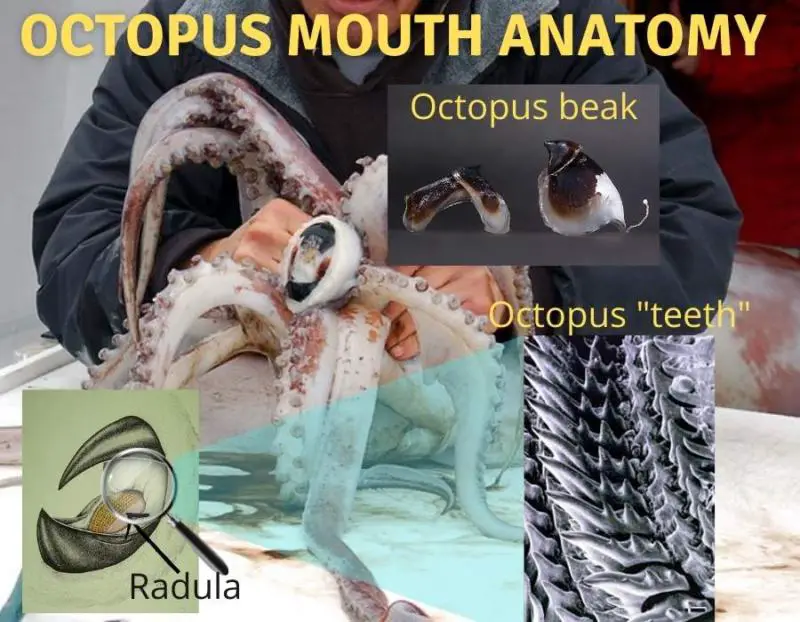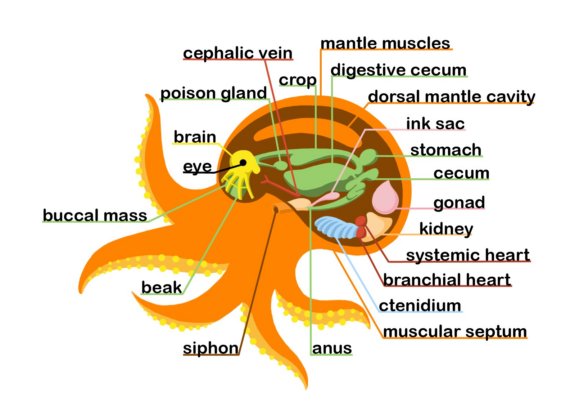Octopuses are cephalopod creatures that belong to the invertebrates group just like squid and cuttlefish. They are known for their intelligence and camouflage skills that allow them to deceive attackers and prey.
Their soft bodies make them capable of fitting into narrow and small spaces, and the only hard object in an octopus body is found in its beak-like mouth – but does an octopus have teeth?
Octopuses have a beak like a parrot rather than a mouth like ours, it does not have teeth in the classical sense.
However, an octopus does have a tongue-like structure called the radula, which is covered in small teeth structures (denticles). Similar to the function of our teeth, these are used by the octopus to process its food.
While the radula is considered the octopus tongue, scientists believe that this organ is more teeth-like than tongue-like because of its rasp-like structure of tiny sharp teeth called denticles.
The radula of octopuses typically has around 7 teeth in each row as part of more than 30 teeth rows per radula, resulting in the octopus having several hundred teeth in total.
The radula is responsible for cutting and drilling holes in the prey. It also scrapes the food particles from the prey surface, particularly shellfish.
Does an octopus have a mouth?
The short answer is yes. The octopus has a hidden mouth in the center of its web of eight tentacles.
However, unlike the mouth we and other mammals have, it serves as a place that encloses the only hard part of the octopus body, which is a beak similar to that found in birds, rather than teeth.
The beak lies hidden inside the buccal mass or mouthparts of the octopus and is surrounded by appendages where it serves as the first part of the octopus’ digestive system.
The beak has two parts namely the upper beak and lower beak which are held together by a bridge and shoulder structure. The upper beak measures approximately 2.2 to 12.9 mm and the lower beak measures about 1.8 to 9.7 mm depending on the octopus’s size.
The beak of an octopus is made from material resembling a fingernail rather than a bone, but it is exceptionally tough.
As part of the octopus’ mouth is a primary salivary gland called the salivary papilla. Unlike fish, but similar to most birds and reptiles’ salivation capabilities, octopuses actually do produce saliva, but also a paralyzing venom.
Interestingly, the salivary gland of octopuses has a hard part that may be used by the octopus to drill through hard materials such as clamshells and allows octopuses to eat crabs despite their exoskeletons.

Octopuses also possess a type of venom that results in the paralysis of their prey. This venom is delivered by the extruding salivary papilla after boring into its prey.
This feature is not only found in octopuses but also in predatory snails such as the moon snail.
As mentioned in the introduction, octopuses have a tongue-like structure in their mouths called the radula. However, the radula does not resemble the tongue of humans, as it is spiky and rough rather than soft. It also has a different purpose than the tongue of most other animals.
While radula does not possess any sense of taste, octopus tentacles possess sensory organs able to detect flavor and odor upon contact.
How does an octopus chew its food then?
When it comes to eating and breaking down food, the octopus uses its hardened scissor-like beak, its radula covered in teeth-like structures, and the digestive enzymes released by its salivary glands.
When the octopus is successful in its hunt, the beak bites the prey and releases its venom regardless of whether it has to drill through the prey or not. Once the venom is injected into the prey, it will be paralyzed.
After paralyzing its prey, the octopus can use its beak to hold its prey still and to cut it into manageable pieces.
The octopus beak can break the shells of different ocean creatures, However, for bigger shells, the beak might not be able to break them. In this scenario, the powerful sucking ability of its tentacles can force the shells apart to take the meat out of the shell.
Here, the tooth-covered radula helps the octopus scrape out the meat that is fastened to shells, and it may even be used to “chew” through shells that cannot be opened otherwise.
Can an octopus bite you?
Yes. Just like any creature, an octopus can in theory attack and bite anyone at any time whenever it catches sight of danger.
However, unlike other predators, octopuses typically avoid humans and aren’t dangerous creatures when undisturbed.
They are usually more scared of you, than you are of them.
However, in the rare incident that a bite happens, octopus bites can result in excessive bleeding and injuries to people.
If an octopus were to bite a human, it would usually do it in a quick threatening fashion, and would not inject poison, because its intention is to scare you rather than to eat you.
This would simply feel like a tiny pinch of your skin.
If the octopus continuous to feel threatened, it may proceed to inject its paralyzing poison.
Most octopus venoms are not lethal to humans or larger animals except for the venom from the blue-ringed octopuses (Hapalochlaena spp.), which can be dangerous in severe cases and may even kill larger predators such as sharks.

Interestingly, what sets the blue-ringed octopus apart from other octopuses is that its venom is actually not produced entirely by the octopus itself, but partly by bacteria found in its salivary glands.
This venom known as tetrodotoxin causes nausea, respiratory arrest, paralysis, and blindness that can lead to death when not treated within minutes. There are no known first aids when a person is poisoned by the blue-ringed octopus rather than going to the emergency room of a hospital to get necessary treatments.
However, the less severe venom of most octopuses would not be able to paralyze more than a limb at a time and would resolve within hours. Here, hot water applied to the injection site is said to speed up recovery.
Nevertheless, there are still very few records of humans being seriously injured by octopuses. If you ever got caught in an octopus attack situation, remember to pull away quickly, prevent the octopus tentacles from enveloping you, and swim toward the surface.
How does an octopus digest its food?
The digestive system of an octopus is relatively simple. It is composed of the buccal mass, esophagus, crop, caecum, intestines, and anus. Although these parts are relatively simple, the digestive process itself is complex.
After paralyzing its prey and injecting its digestive enzymes, the octopus begins the devouring process by penetrating into the prey’s shell or outer skin with its beak or radula.
The food is then broken down using the beak in radula into bite-sized pieces for more efficient digestion.

The food moves from the buccal mass or mouthparts where the food is “chewed” by the teeth on the tongue-like structure radula.
From the buccal mass, the food travels to the crop via the esophagus. In the crop, the food is partially stored and further processed.
Does an octopus have a stomach?
Yes! But although octopuses have three hearts and 9 brains they only have one stomach.
A stomach is part of the octopus’ simple digestive system. The next compartment is where the partially ground food goes after passing the crop.
The food gets partially digested in a crop first before it reaches the stomach and finally the caecum and intestines. Not unlike the crop of birds, the crop is a sac where food is temporarily stored before it passes through the digestive tract and reaches the stomach.
The digestion process of octopuses also varies from other animals because octopuses don’t just digest their food in their stomach but also in other parts.
For the final digestion and absorption, the food travels to the caecum and intestines where nutrients are absorbed.
When there is undigested food, it is secreted by the anus. The total digestion time of the octopus can take up to 7 hours.
The digestion of an octopus is not unlike that of a squid and many other sea creatures without teeth. For example, crabs also have mouths without teeth but they use a crop-like structure called a “gastric mill” to grind their food instead of chewing it!
Conclusion
Octopuses are cephalopod creatures that have a beak like a parrot rather than a mouth like ours, it does not have teeth in the classical sense.
The radula is responsible for cutting and drilling holes in the prey. It also scrapes the food particles from the prey surface, particularly shellfish.
The octopus has a hidden mouth in the center of its web of eight tentacles which serves as a place that encloses the only hard part of the octopus body, which is a beak similar to that found in birds, rather than teeth.
The beak of an octopus is made from material resembling a fingernail rather than a bone, but it is exceptionally tough.
Can an octopus bite you? Yes. Just like any creature, an octopus can attack and bite anyone at any time whenever it catches sight of danger. However, most octopuses are not dangerous creatures when undisturbed. If an octopus were to bite a human,
Octopuses also possess a type of venom that results in the paralysis of their prey. This venom is delivered by the extruding salivary papilla after boring into its prey.
When it comes to eating and breaking down food, the octopus uses its hardened scissor-like beak, its radula covered in teeth-like structures, and the digestive enzymes released by its salivary glands.




